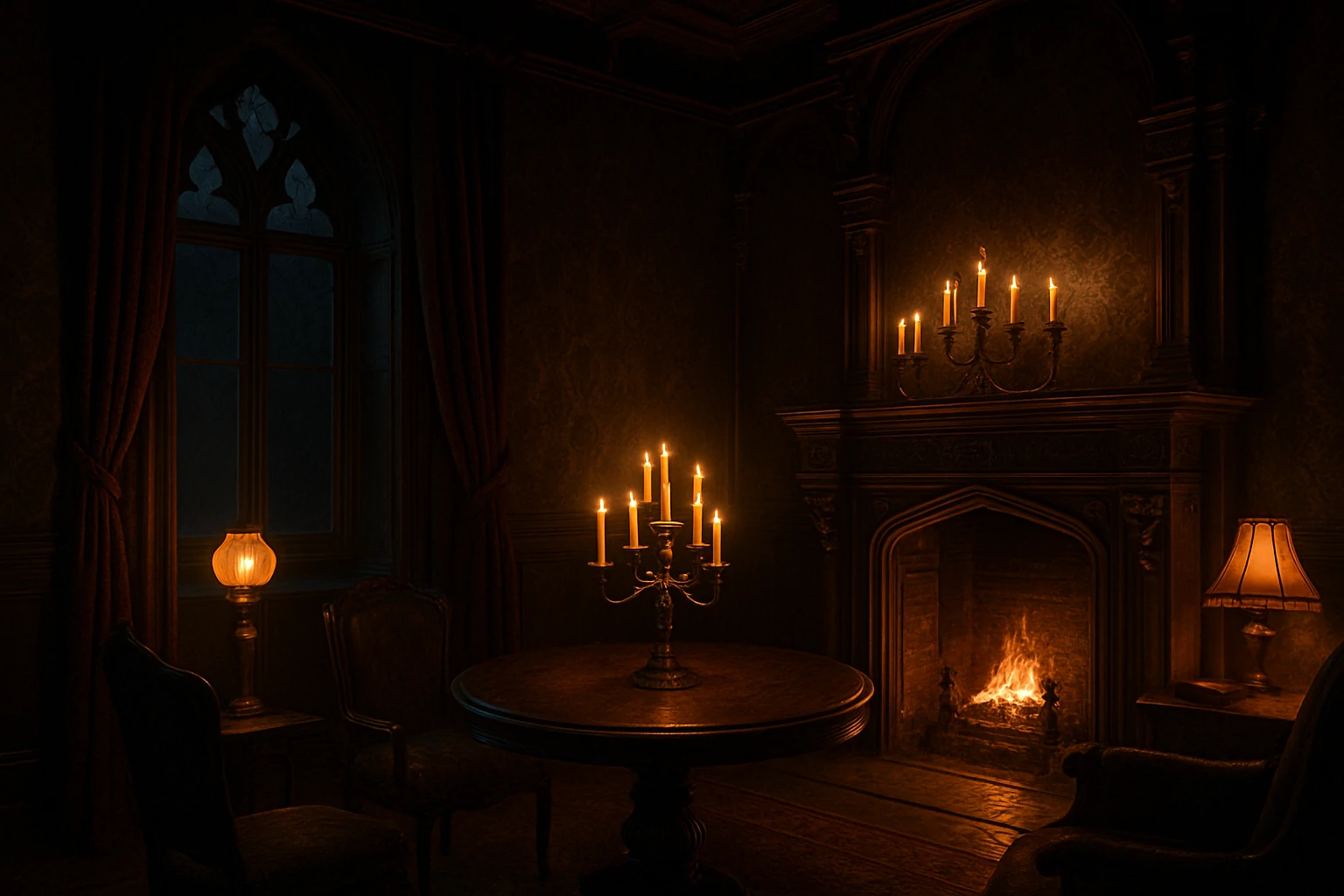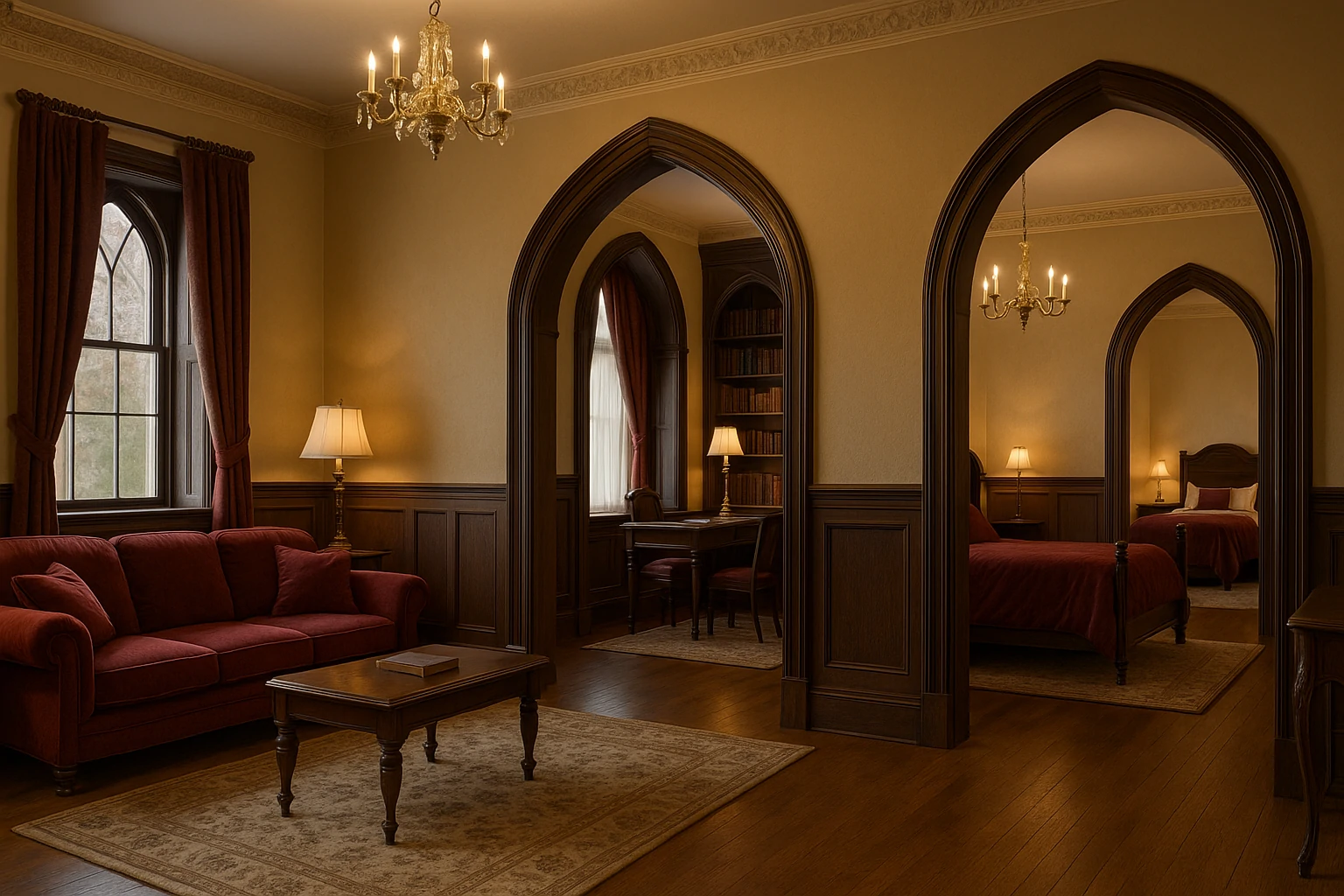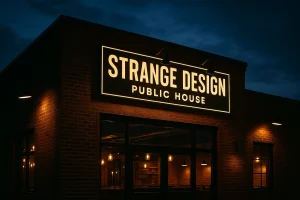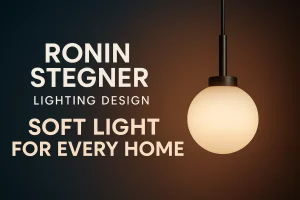Victorian Gothic interior design is more than style. It builds a room full of mood and meaning. This look began in the 1800s, during Queen Victoria’s time. It came from a deep love for medieval art, strong buildings, and dark romance. Many homes used dark wood, velvet, and soft light to show power and beauty.
The style feels rich and bold. It does not aim to look soft or plain. You see carved furniture, arched windows, and heavy curtains. These rooms feel like old castles or libraries. Every item adds weight and purpose. The design speaks through shape, color, and detail.
Light and shadow work together in this style. Black chairs sit near gold mirrors. Dark walls glow in soft lamp light. The room may feel heavy, but never dull. Each piece fits into the story. Nothing feels random or out of place.
If you love history, books, or dramatic charm, this style may fit you. This guide will show you clear steps to create a space that feels bold, deep, and timeless.
How Victorian Gothic Style First Took Shape
This style took shape in the 1800s. Architects studied old castles and cathedrals. They brought back stone arches, stained glass, and strong lines. These designs first appeared in large churches. Soon, they found their way into private homes. Wealthy families used them to show power and taste.
Writers helped build the mood. Poe and Shelley wrote stories with fear and beauty. Their words left a mark. People wanted rooms that matched those feelings. Homes began to feel like scenes from dark novels. Thick curtains, carved wood, and deep colors filled the space.
The Victorian side added charm. It brought balance and grace. Gothic gave strength and emotion. Together, they shaped a style that felt bold, rich, and full of story.
The Mood: Drama, Darkness, and Detail
Victorian Gothic design does more than decorate a space. It builds emotion. It tells a quiet story through color, texture, and shape. Every room should feel like it holds a secret. You walk in and sense the weight of time. It feels deep, still, and powerful.
This style mixes light and dark in strong ways. You see velvet chairs beside tall black shelves. You notice a gold frame glowing on a shadowed wall. Candlelight adds a soft glow. Thick curtains close out the world. Each piece works with the next to create a scene.
The beauty lies in contrast. One side gives calm and elegance through silk, trim, and shape. The other side brings bold lines, dark tones, and deep silence. When balanced, this mix brings rooms to life. It feels rich, layered, and full of soul.
The way a home reflects who you are comes into focus through tone and detail, as shown in “Why Interior Design Is Interesting” on MintPalDecor.
I became insane, with long intervals of horrible sanity. – Edgar Allan Poe
Essential Elements That Define the Style
To build this look, you need to focus on specific elements. Each piece helps shape the full design.
1. Dark and Rich Colors
Start with deep shades. Black, burgundy, forest green, navy blue, and dark purple all work well. These colors create the moody base of the room. You can add cream, gold, or silver to break up the darkness. Keep the light accents soft and aged. Avoid anything too shiny or bright.
2. Heavy and Luxurious Fabrics
Fabrics play a big part in this style. Use velvet, brocade, and damask on chairs, sofas, and curtains. Choose thick materials that look and feel rich. Add trim, fringe, or tassels for extra detail. These fabrics should look like they belong in an old manor or royal room.
3. Detailed and Carved Furniture
Use wooden furniture with carvings, curves, and high backs. Pick pieces made from dark woods like mahogany or walnut. Look for classic shapes with legs that have design, not plain lines. Chairs, tables, and cabinets should look bold and strong.
4. Decorated Walls and Ceilings
Cover walls with patterned wallpaper. Use florals, Gothic motifs, or damask prints. You can also add wooden wall panels or trim. Ceilings can include beams, medallions, or textured plaster. Crown molding adds polish and elegance to the top edges of the room.
5. Windows and Lighting That Set the Mood
Tall windows with pointed arches fit well. Use thick drapes to frame them. Heavy tiebacks help the curtains fall neatly. Choose chandeliers, wall sconces, and candle-style lights for soft glow. Stained glass adds color and mystery. Lamps should feel old or antique.
6. Grand Fireplaces and Mantels
Fireplaces are often the heart of a Gothic room. Use stone, brick, or cast iron. The mantel should have carved details. Place antique clocks, dark art, or candles on top. Make the area feel like a special scene in a story.
7. Accessories and Finishing Pieces
Use mirrors with gold or black frames. Hang dark art, vintage portraits, or romantic paintings. Add old books, candle holders, busts, and decorative boxes. Every item should feel like it has history. Keep it tasteful, not crowded.
How to Use the Right Colors the Right Way

Color sets the mood. In Victorian Gothic design, it must feel deep and rich. Start with two strong dark colors. Add one soft light color to balance the look. This keeps the room grounded but not heavy.
Red and black work well with touches of gold. Green pairs nicely with cream or deep brown. Navy and purple blend well with silver. These color sets add warmth and contrast. Pick shades that feel aged and soft, not bright or modern.
Use matte paint on walls to control light and shine. Glossy paint does not match this style. Let your dark tones cover large areas like walls, rugs, or furniture. Use the light color in small details. Try it in pillows, curtains, or trim.
Stick to three main shades. Adding more can confuse the room. Keep your palette tight. This makes the space feel bold but clean. You want the colors to feel planned, not random. A strong palette brings depth without making the room feel crowded.
Victorian Gothic Design Ideas for Your Home
Here are a few simple ways to bring this style into your home without a full remodel:
- Paint one wall in deep burgundy or charcoal gray
- Add velvet pillows in dark red or forest green
- Hang a gold-framed mirror above a fireplace or entryway
- Use a carved wooden chair with a high back
- Place candlesticks or an antique clock on a side table
- Choose patterned wallpaper with floral or Gothic prints
- Drape dark fabric over a bookshelf or cabinet
- Add a vintage rug under your coffee table or bed
Start with one idea. Build slowly. Let the room grow with time.
Furniture Placement Tips for Balance and Drama
Layout shapes the mood of the room. In Victorian Gothic design, balance matters. Place large furniture across from each other. Use matching pairs when possible. Two chairs, two lamps, or two shelves add structure. This kind of symmetry helps the room feel calm and strong.
Make the fireplace or a feature wall your main focus. Center your seating around it. Let this area guide how you place everything else. The eye should move toward that spot first.
Do not crowd the space. Choose a few strong pieces and give them room. Let one bold chair or a carved table take the spotlight. Use area rugs to group items into smaller zones. A rug under a table or between two chairs gives shape and comfort.
Keep walkways clear. People should move through the room with ease. Tight paths can still feel cozy. Just make sure the layout flows. A clear layout with good spacing will help the room feel rich, not cramped.
Lighting: How to Set the Gothic Mood

Lighting sets the tone in Victorian Gothic design. Soft and warm light works best. Stay away from bright ceiling lights or modern white bulbs. These feel too sharp. Instead, use chandeliers, vintage lamps, or wall sconces. Look for lights with black or brass bases. Shades in dark or muted tones help soften the glow.
Mirrors can help spread the light. Place lamps close to reflective surfaces. This adds depth and brings a quiet shimmer to the room. Choose bulbs with a soft yellow hue. Harsh blue light ruins the mood. Every light should feel like it belongs in an old library or candlelit hall.
Do not leave bulbs exposed. Use covers or shades. Add real or flameless candles to tables, shelves, and mantels. Candlelight gives a room warmth and charm. The right lighting does not just brighten the room. It makes the space feel deep, calm, and full of story.
Textures That Add Feeling and Depth
Use a mix of soft, hard, smooth, and rough textures. Velvet and silk give comfort. Wood and stone bring strength. Metal details add edge. Use fur throws, embroidered pillows, or carved picture frames.
Each item should feel different. Texture adds life. It helps the room tell a deeper story. You want your space to invite touch, not just sight.
Victorian Gothic vs. Modern Gothic: What’s the Difference?
| Feature | Victorian Gothic | Modern Gothic |
|---|---|---|
| Main Influence | 1800s architecture and literature | Minimalism with dark tones |
| Furniture Style | Carved wood, antique, large pieces | Sleek shapes, smaller frames |
| Color Palette | Deep reds, forest green, black, gold | Black, gray, matte white, with soft contrast |
| Textures | Velvet, brocade, silk, fringe | Leather, metal, smooth stone |
| Lighting | Candlelight, sconces, stained glass | Matte fixtures, low-wattage bulbs |
| Decor Style | Romantic, detailed, layered | Clean, moody, simple |
| Mood | Rich, dramatic, historical | Calm, dark, modern |
| Common Spaces | Libraries, dining rooms, parlors | Lofts, bedrooms, living rooms |
How to Add Modern Pieces Without Losing the Look
You can use new items that still fit the style. Pick modern furniture with classic shapes. Use new fabrics with old-style prints. Hide TVs and tech inside cabinets. Avoid plastic, chrome, or neon.
Add a modern table lamp with a black base. Use updated sofas in deep colors. Balance is key. New and old can live together if you blend them with care.
One approach draws from the layered, warm spaces seen in Nancy Meyers’ interiors, where modern comfort meets timeless elegance.
Rooms That Look Best in Victorian Gothic Style

This style does not work in every room. Use it where it makes sense and feels natural.
Living Room
Use carved chairs, a dark rug, and art with drama. Add tall curtains and a bold mirror. This room lets you go big.
Library or Study
Bookshelves, a leather chair, and dim lights work well. Add a globe or antique desk. This is the heart of Gothic charm.
Bedroom
Choose a tall headboard in dark wood. Use velvet or silk bedding. Hang curtains that block light. Add soft rugs and candles.
Dining Room
Use a long table and tall chairs. Add a vintage chandelier. Decorate the walls with framed art or a mirror.
Victorian Gothic Interior Design Living Room
The living room is the best place to show off this style. It’s where you can go bold without losing comfort.
Try these ideas:
- Use a large velvet sofa in a dark tone
- Add carved wooden armchairs with damask cushions
- Frame the room with long curtains in deep red or black
- Place a chandelier over the center of the room
- Anchor the space with a Persian-style rug
- Decorate your mantel with candles and an antique mirror
- Use a dark wall color with gold or cream accents
This room sets the mood for the whole home. Make it rich, calm, and full of detail.
Mistakes That Can Ruin the Look
Even one wrong move can break the mood. This style needs care, not clutter. Here are the biggest mistakes to avoid:
- Too much pattern: One or two patterns add style. More than that feels busy and off. Keep it controlled.
- Too many colors: Pick two dark tones and one soft shade. That’s enough. A fourth color starts to distract the eye.
- Bright or glossy finishes: High gloss kills the mood. Shiny white paint or plastic chairs do not belong here.
- Modern lighting: A bright white bulb can ruin hours of effort. Use soft yellow light only. No bare bulbs.
- Flat rooms with no texture: Smooth surfaces everywhere feel empty. Mix velvet, wood, metal, and stone to add life.
- Crowding every corner: You don’t need to fill the space. A few bold pieces feel stronger than ten small ones.
- Random decor that feels cheap: Plastic frames or fake flowers will stand out-in the wrong way. Every item should look like it has a past.
- No symmetry: Gothic rooms feel better with balance. Try two matching chairs, mirrors, or lamps. Even layout matters.
- Ignoring the focal point: Every room needs one strong center. It could be the fireplace, a mirror, or a tall headboard. Don’t let the room drift.
This style is bold, but it needs balance. Keep things clean, rich, and full of story. Less noise, more meaning.
Where to Shop for Victorian Gothic Decor
Look in vintage stores, estate sales, or antique shops. Online shops may carry Gothic-themed furniture and art. Search with terms like “Gothic revival decor” or “Victorian style lighting.”
Buy one piece at a time. Start with a chair, table, or mirror. Build around it. That keeps the space honest and unique.
You can also look at modern creators who blend Gothic and soft ambient tones, like those explored in Ronin Stegner’s lighting design, which shows how light can tell a visual story.
Final Touches to Bring It All Together
Small touches make a big impact. Add items that look classic but do not crowd the space. Use brass candle holders, vintage frames, or dark roses in a simple vase. Place a velvet cloth on a wood table or chair. A carved bust or antique clock in a quiet corner adds charm and weight.
Scent gives the room a deeper feel. Pick rich smells like sandalwood, rose, or clove. Use thick candles or oil diffusers. These scents should feel calm and full. A soft smell adds age and warmth to the room. It helps everything feel connected and complete.
Sound adds the final piece. Play slow classical music in the background. A fire crackling nearby adds comfort. Each sense should work with the others. When the light, scent, texture, and sound match, the room feels alive. Every part works together to tell a quiet story.
🧾 Quick Style Summary
- Deep, rich colors set the tone.
- Velvet, carved wood, and soft light add depth.
- A few strong pieces feel better than many small ones.
- Textures and lighting shape the mood.
- Balance darkness with soft detail and warm glow.
Conclusion: A Style That Speaks to the Soul
Victorian Gothic design does more than fill space-it tells a story. Every part of the room carries weight. The colors, textures, and shapes all work together to build a feeling. This is not just decoration. It is emotion in form. A home with this style holds history and silence. It feels full of thought, memory, and purpose.
This look fits those who love meaning in their space. If you enjoy old books, quiet nights, or deep tones, this design may feel like home. You do not need to start big. Choose one dark color for a wall. Bring in one carved chair or velvet pillow. Hang one moody painting or mirror. Let your design grow step by step. Each new item adds to the voice of the room.
You do not live beside this style-you live inside it. It wraps around you. It slows time. It speaks without sound. Victorian Gothic interior design is not fast or trendy. It is timeless. It brings the past into the present and makes your home feel bold, rich, and alive.





Pingback: Ice Cream Shop Interior Design: Complete Guide